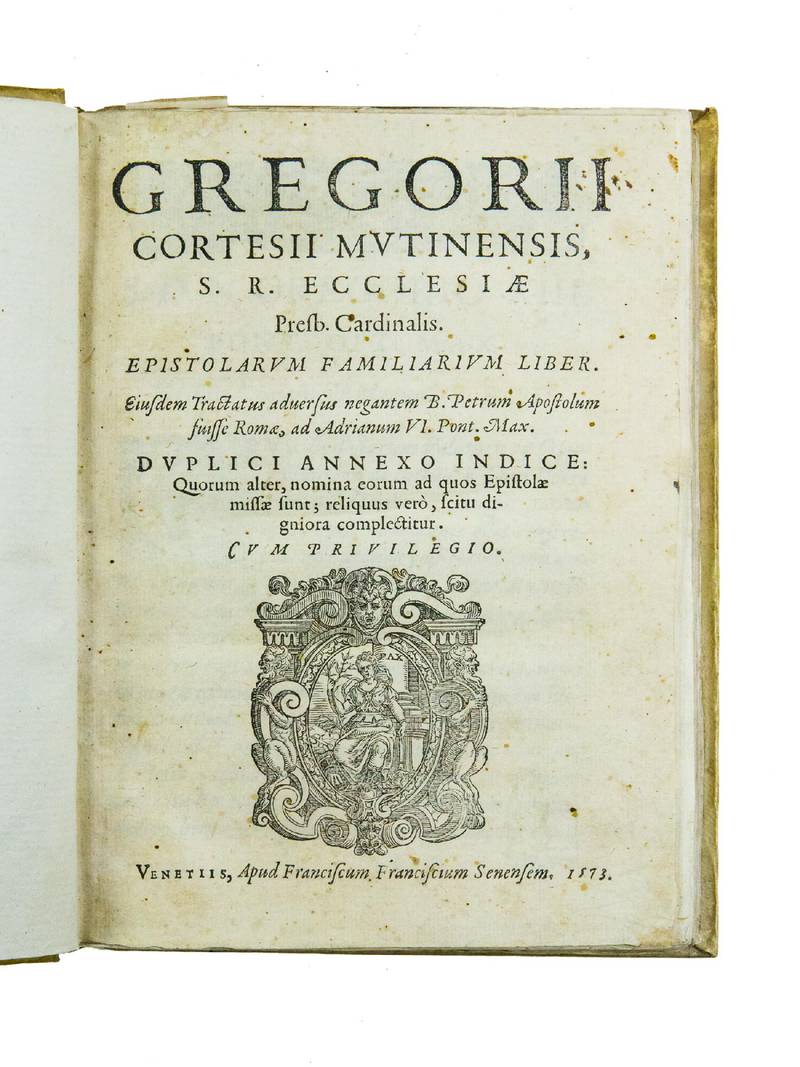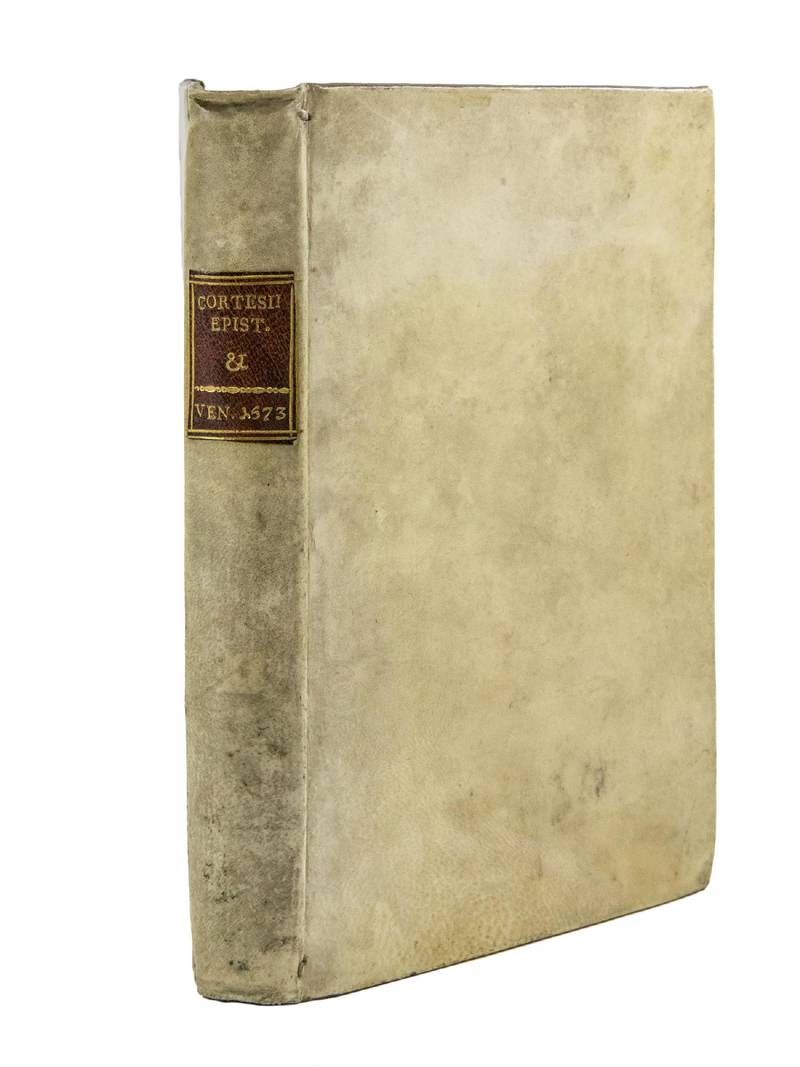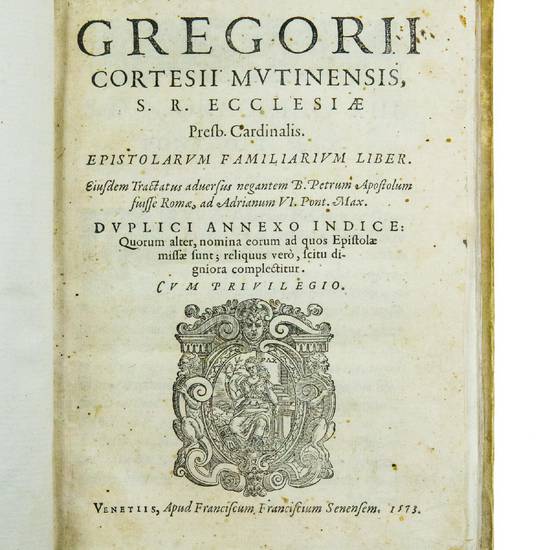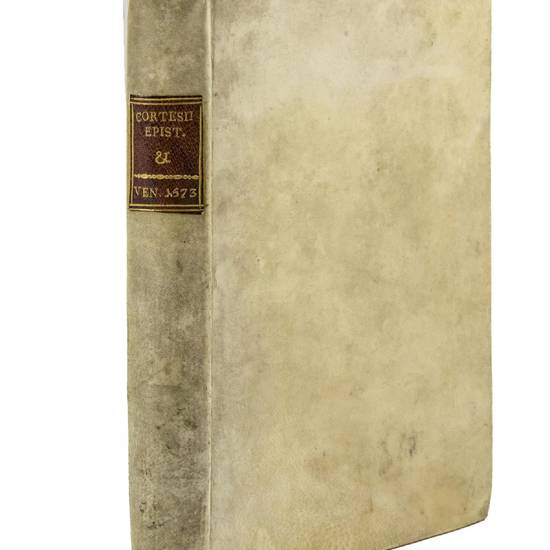4to. (12), 362 pp., 1 blank leaf. a4, b2, A-Z4, Aa-Yy4, Z2. With the printer's device on the title-page. Old vellum, from the library of the scholar and book collector Giulio Bernardino Tomitano (1761-1828) with his autograph note on the front free endpaper.
Adams, C-2709; Edit 16, CNCE 13577; Index Aureliensis, 145.437; F.C. Cesareo, Humanism and Catholic Reform. The Life and Work of Gregorio Cortese (1483-1548), (New York & Bern, 1990), p. 183; G. Gueudet, L'art de la letter humaniste, F. Wild, ed., (Paris, 2004), p. 653.
FIRST EDITION. It was dedicated to Pope Gregory XIII and published by Cortese's niece, Ersilia Cortese del Monte (1529-after 1587), by whom is also the Cortese's short biography printed before the indexes.
Ersilia was the natural daughter of Jacopo Cortese, a wealthy lawyer from Modena. She received an excellent education at Tome and married in 1544 Giambattista del Monte, nephew of Cardinal Giovanni Maria Ciocchi del Monte (later pope Pius III), who legitimized her before her marriage. Her husband died during the siege of Mirandola (1552), while leading the papal army against the Ferrarese. Ersila then refused all re-marriage proposals and devoted herself to her studies. She abandoned Rome at the election of Paul IV (1555), who was an enemy of the del Monte family. She returned only from her exile when Pius IV was hailed as new pope (1559). Ersilia was engaged in an epistolary exchange with Pietro Aretino and had contacts with Annibal Caro, Girolamo Ruscelli, Sperone Speroni, and Bernardo Tasso. She also wrote poetry, some of which was included in the verse collection edited by Muzio Manfredi, Per donne romane (Bologna, 1575) (cf. E. Melfi, Ersilia Cortese, in: “Dizionario Biografico degli Italiani”, Roma, 1983, pp. 719-721).
At the end of the volume is printed Cortese's tract Adversus negantem Petrum Apostolum Romae fuisse, dedicated to pope Adrian VI, a refutation of a pamphlet written by the Bohemian scholar Oldrich Velensky, in which he denied that the apostle Peter had ever been in Rome (cf. A.J. Lamping, Ulrichus Velenus and his Treatise against the Papacy, Leiden, 1976, Chapter I).
“The letters of Cortese not only display his skill in the classical languages, but also attest to his mastery of them. Benedetto Teocreno [Tagliacarne], writing to Cortese about the style of his letters, declared that they exhibit ‘an excellent choice, an incredible candor, an admirable force and efficiency in words; in sentences, their own – totally fitting – weightiness, a delightful variety, a most becoming charm, a perspicacity on both sides – to a degree I had hardly believed could be shown today' ” (F.C. Cesareo, op. cit., p. 160).
Ferro, Jacopo (p. 1)
Sadoleto, Jacopo (p. 4)
from Sadoleto, Jacopo. Roma, May 31, 1518 (p. 7)
Longueil, Christophe de (p. 9)
from Longueil, Christophe de. Roma, January 25, n.y. (p. 12)
Sauli, Stefano (p. 14)
Calcagnini, Celio (p. 16)
Navagero, Andrea (p. 17)
Sauli, Stefano (p. 19)
Tagliacarne, Benedetto (p. 21)
id. (p. 23)
id. (p. 25)
Sauli, Stefano (p. 27)
id. (p. 29)
Palmario, Girolamo (p. 31)
Tagliacarne, Benedetto (p. 33)
Grimaldi, Agostino (p. 34)
Sauli, Stefano (p. 35)
Grimaldi, Agostino (p. 37)
Fregoso, Federico (p. 38)
[Arbaud], Lambert (p. 40)
Grimaldi, Agostino (p. 41)
Adorno, Girolamo (p. 44)
id. (p. 46)
id. (p. 47)
Tagliacarne, Benedetto (p. 49)
[Grimaldi], Luciano, [Prince of] Monaco (p. 53)
Dionysio Monacho [Faucher, Denis] (p. 55)
Iulianus Monachus (p. 56)
Tagliacarne, Benedetto (p. 57)
Longueil, Christophe de (p. 59)
Sauli, Filippo (p. 61)
Cassiani, Camillo (p. 64)
Franciscus de Sancto Venerio (p. 66)
Adorno, Girolamo (p. 68)
Sadoleto, Jacopo (p. 73)
id. (p. 75)
Cassiani, Camillo (p. 76)
[Grimaldi], Luciano, [Prince of] Monaco (p. 78)
Fregoso, Federico (p. 80)
Girolamo di Monferrato (p. 83)
Monelianus, Hieronymus (p. 86)
Sauli, Stefano (p. 88)
Iulianus Monachus (p. 89)
Grimaldi, A[gostino] (p. 92)
Flisco, [Giovanni] Battista (p. 93)
Cassiani, Camillo (p.96)
Grimaldi, Agostino (p. 98)
Cassiani, Camillo (p. 99)
Ghinucci, Girolamo (p. 101)
Fregoso, Federico (p. 103)
id. (p. 106)
id. (p. 107)
Tagliacarne, Benedetto (p. 109)
Fregoso, Federico (p. 111)
id. (p. 112)
from Fregoso, Federico (p. 114)
Fregoso, Federico (p. 117)
id. (p. 119)
from Fregoso, Fedrico (p. 121)
Fregoso, Federico (p. 122)
id. (p. 124)
from Fregoso, Federico (p. 125)
from Tagliacarne, Benedetto (p. 127)
id. (p. 129)
Sauli, Stefano (p. 131)
id. (p. 132)
id. (p. 134)
id. (p. 135)
from Sauli, Stefano (p. 138)
from Severus Monachus Cistercien. (p. 138)
Severo Monacho (p. 139)
Abbati cuidam (p. 142)
Ferro, Iacopo (p. 145)
[Du Bellay], Guillaume, Sieur de Langey (p. 147)
Dionysio Monacho [Faucher, Denis] (p. 149)
Helisaeo Monacho (p. 152)
Girolamo di Monferrato (p. 155)
Helisaeo Monacho (p. 161)
Georgio Monacho (p. 162)
Borlasca, Vincenzo (p. 170)
Raphaeli Placentino Monaco (p. 174)
[Arbaud], Lambert (p. 176)
Grimaldi, Agostino (p. 179)
Fregoso, Federico (p. 183)
Rascasio Iuriconsulto (p. 185)
Tagliacarne, Benedetto (p. 185)
Grimaldi, Girolamo (p. 188)
Sassi, Pamfilo (p. 189)
id. (p. 191)
Sauli, Filippo [in Greek] (p. 192)
id. [in Greek] (p. 193)
from [Faucher, Denis] Dionysio Monacho (p. 194)
Dionysio Monacho [Faucher, Denis] (p. 195)
id. (p. 197)
id. (p. 198)
from Franciscus de Santo Venerio (p. 200)
Franciscus de Santo Venerio (p. 201)
Tagliacarne, Benedetto (p. 203)
id. (p. 205)
from Vitalis Monacus (p. 208)
Vitali Monaco (p. 209)
Fregoso, Federico (p. 211)
Sadoleto, Jacopo (p. 212)
Longueil, Christophe de [in Greek] (p. 213)
Fregoso, Federico (p. 215)
Bentin, Michael (p. 216)
Fregoso, Federico (p. 217)
id. (p. 219)
Medici, Giovanni de' (p. 220)
Fregoso, Federico (p. 223)
Henriot, Perpétue (p. 225)
Fregoso, Federico (p. 226)
Vitali Monaco (p. 228)
Dionysio Monacho [Faucher, Denis] (p. 229)
Eusebio da Modena (p. 232)
Medici, Giovanni de' (p. 234)
Duprat, Antoine (p. 237)
Michaeli Placentino Monaco (p. 239)
id. (p. 242)
Dionysio Monacho [Faucher, Denis] (p. 244)
from Morone, Giovanni (p. 246)
Morone, Giovanni (p. 246)
Leo X (p. 247)
[Grimaldi], Agostino (p. 251)
Vitali Monaco (p. 253)
Sadoleto, Paolo (p. 255)
Vitali Monaco (p. 256)
Dionysio Monaco [Faucher, Denis] (p. 258)
Amico cuidam (p. 260)
Vitali Monaco (p. 262)
Severo Monaco (p. 264)
Bellincino, Francesco (p. 265)
[Du Bellay], Guillaume, Sieur de Langey (p. 267)
from Paul III. Roma, June 11, 1542 (p. 269)
Paul III. Mantova, June 11, 1542 (p. 270)
id. (p. 272)
from Bembo, Pietro. Roma, June 3, 1542 (p. 275)
Bembo, Pietro. Mantova, June 3, 1542 (p. 276)
from Ridolfi, [Niccolò]. Roma, June 13, 1542 (p. 278)
Ridolfi, [Niccolò]. Mantova, June 30, 1542 (p. 279)
from [Sforza], Guido Ascanio. Roma, June 6, 1542 (p. 281)
[Sforza], Guido Ascanio. Modena, July 1, 1542 (p. 281)
from Salviati, Giovanni. Roma, June 2, 1542 (p. 284)
Salviati, Giovanni. Mantova, May 26, 1542 (p. 285)
from [Laurerio, Dionisio], Cardinal of San Marcello. Roma, June 5, 1542 (p. 286)
[Laurerio, Dionisio], Cardinal of San Marcello. Mantova, [1542] (p. 287)
from the College of Canons of Modena. Modena, June 13, 1542 (p. 288)
to the College of Canons of Modena (p. 289)
from Sadoleto, Jacopo. Saint-Felix [de Malemort], June 9, 1544 (p. 291)
Amico cuidam (p. 295)
from Sadoleto, Jacopo. Saint-Felix [de Malemort], June 30, 1544 (p. 291)
Giovanni Andrea Cortese, born in Modena, received a thorough training in the humanities in his native city under the learned Cistercian Severo Varino of Piacenza. He then devoted himself to the study of jurisprudence for five years, first at Bologna, then at Padua, and was graduated as doctor of laws at the early age of seventeen.
His deep knowledge of the Latin and Greek languages induced cardinal Giovanni de' Medici, the future pope Leo X, to take him into his service and afterwards appoint him legal auditor in the Curia. Desirous of leading a more quiet life, Cortese resigned this office and in 1507 entered the Benedictine monastery of Polirone near Mantua (assuming the name Gregorio), one of the most flourishing abbeys of the recently founded Cassinese Congregation. When Cardinal Giovanni de' Medici heard that his former auditor had become a monk, he addressed a letter to him expressing his surprise and his displeasure at the step which Cortese had taken and urging him to leave the monastery and resume his former occupation in Rome. In his answer to the cardinal's letter Cortese points out the great dangers which beset his soul when he was still engaged in worldly pursuits, and speaks of the interior happiness which he experienced while chanting the Divine praises and applying himself to the study of Holy Scripture. When in 1513 Giovanni de' Medici ascended the papal throne as Leo X, Cortese sent him a letter of congratulation in which, however, he did not omit to remind the new pontiff of his duty to begin at last that general reform of which the Church stood in extreme need. Like many other saintly and learned men of the time, Cortese was deeply grieved at the indifference manifested by many ecclesiastical dignitaries towards a wholesome internal reform of the Church. It is due to his untiring zeal that the Benedictine reform, which had recently been inaugurated in Italy by the Cassinese Congregation, was carried through, and that, with the return of monastic discipline, the Benedictine monasteries of Italy again became seats of that learning for which they had been so famous in the past.
In 1516 Agostino Grimaldi, bishop of Grasse and abbot of the monastery of Lérins, united his monastery with the Cassinese Congregation, and, upon the bishop's request, Cortese and a few others were sent thither to assist in introducing the Cassinese reform. Here Cortese devoted himself to literary pursuits, and in order to promote the study of the humanities, he founded an academy where he and other learned members of the monastery educated the French youth, thus becoming instrumental in transplanting to French soil the literary humanistic movement. The moral and literary reform of Lérins was assured when in 1524 Cortese was elected its abbot. His health, however, was greatly impaired during his sojourn at Lérins, so that in 1527 he considered a change of climate indispensable and asked the superior of the congregation for permission to return to Italy. As a result, he was appointed Abbot of St. Peter's at Modena; a year later, Abbot of St. Peter's at Perugia; and in 1537 Abbot of the famous San Giorgio Maggiore at Venice.
Cortese was now considered one of the most learned men in Italy and had regular correspondence with the greatest scholars in Europe. He counted among his friends Gasparo Contarini, Reginald Pole, Jacopo Sadoleto, Pietro Bembo, Gian Matteo Giberti, and many other humanists and ecclesiastical dignitaries. The garden of San Giorgio was the place where these pious and learned discussions were held to which the Florentine scholar Antonio Brucioli refers in his dialogues on moral philosophy.
In 1536 Pope Paul III made him a member of the committee of nine ecclesiastics who were to draw up a statement of those ecclesiastical abuses which called most loudly for reform. Soon after, he was appointed Apostolic visitor for the whole of Italy and, somewhat later, was sent to Germany to take part in the theological disputation at Worms in 1540, but became sick on the journey and was obliged to remain in Italy. Meanwhile (1538) he became abbot of San Benedetto in Polirone. A few times, moreover, he was chosen visitor general of his congregation. Finally, on June 2, 1542, Pope Paul III created him cardinal-priest and appointed him a member of the committee of cardinals for the preparation of the Council of Trent. Towards the end of the same year he became Bishop of Urbino. During the five years of his cardinalate he was an esteemed friend and adviser of Paul III, and used all his influence to bring about that reform of the Church for which the better sort of ecclesiastics had been clamouring many years.
Cortese was one of the best-known writers of his times. He was master of such a finished style that the classically trained cardinal Pietro Bembo and others did not hesitate to class him among the most elegant Latin writers of this humanistic period. His principal works are his epistles, some Latin poems, the already mentioned treatise proving that St. Peter was in Rome, a Latin translation of the New Testament from the Greek texts, and a historical work on the destruction of Genoa. All his extant works were collected and edited with a biography of the author by the Benedictine bishop Gradenigo of Ceneda (Padua, 1774) (cf. F.C. Cesareo, op. cit., passim).
[9018]





